|
MOUNT SAINT
HELENS
|
|

|
|
The following is an illustrated
overview of the geology of the Mt. St. Helens area, with an emphasis on
the events of the eruption of May 18th, 1980. The photos are from
various field trips conducted by the author with students from Malaspina
University-College, Nanaimo, British Columbia.
|
To view one of the full-sized
images click on the small image.
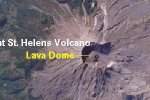 |
|
This NASA satellite image
shows the area around Mt. St. Helens, including many of the features that
are depicted in the photographs below - such as The Toutle River,
Coldwater Lake, the Debris Avalanche deposits, the Pumice Plain, Spirit
Lake and of course the 1980 Crater and the post-1980 Lava Dome. (image
from the USGS Mt. St. Helens website - see reference below) |
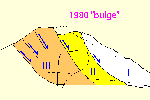 |
|
The sequence of events
surrounding the 1980 eruption is depicted in these two USGS diagrams. In the months leading up to May 1980 magma from beneath
Mt. St. Helens was moving into a small magma chamber on the north side of
the mountain - producing a pronounced, and increasingly unstable
bulge. Just after 8:30 AM on the 18th of May a magnitude 5.1
earthquake triggered a massive landslide in which the side of Mt. St.
Helens collapsed, in three separate blocks, sending an avalanche of debris
into the valley below. (image from
the USGS Mt. St. Helens website - see reference below) |
 |
|
The collapse
of the mountainside exposed the small magma body which had been forming
beneath the bulgem (the cryptodome), and the sudden release of pressure led to a huge
explosion, known as a lateral blast. The lateral blast was followed by a
vertical "plinian" eruption which extended well into the
stratosphere, and sent ash and gases around the world. The vertical eruption
continued for about 9 hours, and produced numerous pyroclasitc
flows. (image from the
USGS Mt. St. Helens website - see reference below) |
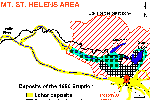 |
|
The lateral blast levelled around
600 square km of forest (blast zone). Material from the pyroclasitc
flows and from falling tephra from the vertical eruption blanketed the
area immediately to the north of the crater (the pumice plain). Numerous lahar floods were also produced during the eruption,
first from water released from the debris avalanche, and then from ice and
snow melted by the eruption and pyroclastic flows. |
| Pre-1980 volcanic features on the
south side of Mt. St. Helens |
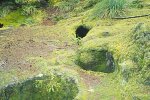 |
|
An eruption of basaltic magma
(roughly 2000
years ago) produced numerous lava-flow features on the southern side of the
mountain. There is also evidence of older lahars and pyroclastic
flows in this region. In an area known as the Trail
of Two Forests lava flowed around an existing forest and killed the
trees. |
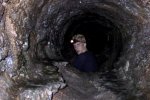 |
|
The trees have since rotted away, leaving open vertical holes
where they once stood and horizontal
tunnels where the trunks were lying on the ground. |
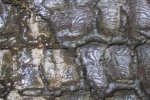 |
|
Imprints of the bark of the
trees are evident on the insides of the tunnels. |
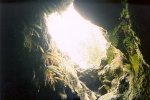 |
|
The same lava flowed into a
nearby stream valley. Lava in contact with the ground and the
air hardened quite quickly, but it continued to flow through a tunnel,
which is now known as the Ape Cave. The cave is around 2 km long, and
in places is over 5 m wide and 5 m high. |
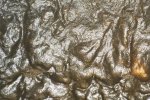 |
|
Magma flowing through the
tunnel spattered against the sides and roof, and then dripped down the
walls. |
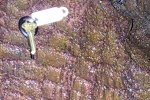 |
|
There are also imprints of
tree bark within the cave. |
 |
|
The cave is home to bats,
spiders and a few other timid creatures. The red colour seen here is a
product of oxidation of existing materials under the hot conditions
related to the lava flow. |
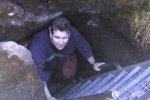 |
|
There are stairs and ladders
to get in and out of the cave, but the cave itself is quite an easy hike. |
| More lava flow features on the south
side of the mountain |
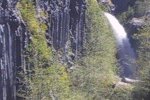 |
|
Lava from the same event
around 2000 years ago flowed into the valley of Castle Creek and is now
exposed in this spectacular canyon. |
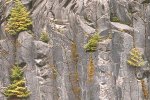 |
|
Columnar basalts formed as
the thick layer of lava cooled. |
| Tephra, pyroclastic flows and
lahar deposits |
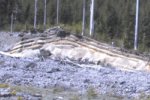 |
|
A major lahar flow
associated with the 1980 eruption sped down a stream valley on the
southeastern side of the mountain and exposed an area with some
spectacular deposits of pre-existing tephra depostis, lahar and
pyroclastic flows. |
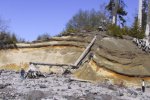 |
|
On some of the
standing trees in the upper right of this photo you can see the scars which were caused by the 1980 lahar. |
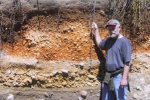 |
|
The bouldery material at the
bottom of the sequence is from an old lahar. That is overlain by the
deposits of two separate tephra falls (yellow and orange colours) and
then by pre-1980 lahar deposits. The 1980 lahar deposits are visible
at the top. |
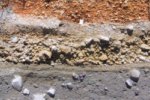 |
|
The characteristics of the
three types of deposits are more clearly visible in this photo. |
| The effects of the 1980 eruption |
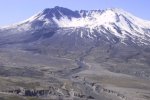 |
|
This view is from Johnston
Ridge into the crater about 10 km away. David Johnston was observing
the mountain from this perspective on May 18th. He would have had a
spectacular view of the beginning of the debris avalanche, but he was
killed very quickly by the lateral blast. His last words, by radio
to the USGS office in Vancouver Washington, were: "Vancouver,
Vancouver, this is it!" The area in the foreground
is known as the Pumice Plain, which consists of thick deposits of tephra, from the main vertical
eruption and from pyroclastic flows. |
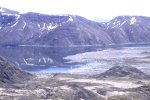 |
|
From the eastern end of
Johnston Ridge you can look down into Spirit Lake, still partly covered
with logs and debris from the 1980 eruption. The lake is quite a bit
higher than it used to be, as it was dammed by the debris avalanche, part
of which can just be seen on the right of this view. |
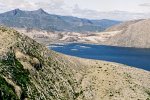 |
|
This is another view of Spirit Lake from the
other direction. Mt. St. Helens is to the left of this
view. Note the blown-down trees on the left. At the time when
this was taken the floating debris in the lake had blown to the other end
of the lake (to the right of this view). (photo
courtesy D. Wilford) |
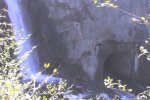 |
|
As the water level in Spirit
Lake rose during 1980, authorities became concerned that it represented a
serious flood threat, since it was being held back only by the loose
deposits of the debris avalanche. The US Army Corps of Engineers
excavated a 2.6 kilometre long tunnel from the lake into the valley of Coldwater
Creek. The outlet of that tunnel can be seen here to the right of
the waterfall. See: https://www.nwp.usace.army.mil/op/b/msh/msh_tunnel.htm |
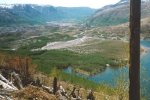 |
|
The Debris Avalanche also
created Coldwater Lake. Part of the debris material can be seen in
the background of this photo. The partly tree-covered fan area in
the centre is a delta built up in Coldwater Lake from the huge amount of
sediment in Coldwater Creek, which emptied directly into the lake for a
number of years. You can see how the near part of the delta, with
the bigger trees, was formed first. |
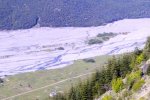 |
|
The north fork of the Toutle
River is also choked with a huge volume of sediment. This view is
about 25 km down stream from the crater area. |
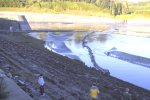 |
|
About 30 km further down
stream the US Army Corps of Engineers built a dam on the Toutle
River. The dam - known as the Sediment Retention Structure - has created a small reservoir which allows some of
the Toutle's heavy sediment load to settle out. See:
https://www.nwp.usace.army.mil/op/b/msh/msh_srs.htm |
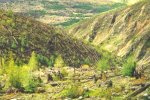 |
|
This picture was taken near
to the edge of the blast zone, looking down into the valley of the Toutle
River - approximately 20 km from the crater. All of the large trees
that were standing in this area were blown over, and if you look carefully
you can see how they all fell in the same direction. |
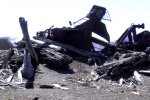 |
|
There was logging operation going on at this
site, some 10 km from the crater. Fortunately there were no workers in
here on Sunday the 18th, although the logging equipment was destroyed by
the lateral blast. |
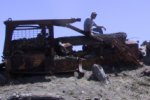 |
|
|
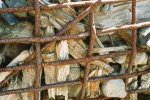 |
|
This is some of the material
that was lodged in the back of the cab of the tractor shown in the
previous image. Picked up by the force of the lateral blast, it
would have been flying through the air at hundreds of km/h. |
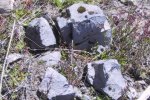 |
|
This chunk of dacite is part
of what is known as a bread-crust bomb - so-named because the outside has
the texture of baked bread. It was hurled out of the volcano during
the main vertical eruption, hardened in the air, and landed on the ground
here, roughly 10 km from the crater. |
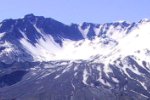 |
|
From 1980 until around 1990 there was a
great deal of volcanic activity within the crater, including some
explosive eruptions and growth of a significant lava dome. Things
have been quite quiet since 1990, but there is still a lot of heat, and
some active hot springs. A new glacier is starting to form on the
shaded walls of the north-facing crater. |
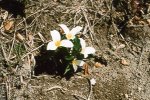 |
|
Much of the area around Mt.
St. Helens has been declared a National Volcanic Monument - a status
similar to that of a National Park. No reclamation has been carried
out within this area. It is being left as a natural laboratory so
that we can observe how regeneration takes place. Much of the region looks
barren, but it is full of life! |
Other Mount St. Helens
information:
The best website on Mt. St. Helens
is from the Cascades Volcano Office of the U. S. Geological Survey:
http://vulcan.wr.usgs.gov/Volcanoes/MSH/framework.html
There is a wealth of information
there, plus a page of links to other resources on Mt. St. Helens and other
volcanoes.
I also strongly recommend the
field guide: Roadside Geology of Mt. St. Helens National Volcanic Monument,
by Patrick Pringle, Washington Department of Natural Resources, Information
Circular 88, 1993.
Steven
Earle, Department of Geology, Malaspina University-College, Nanaimo, B.C., http://www.mala.bc.ca/~earles
November 2001














